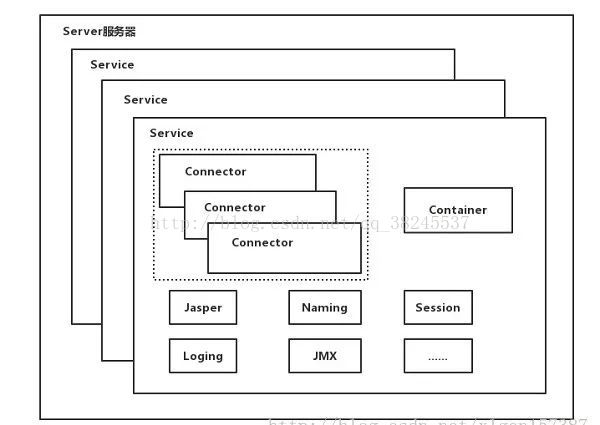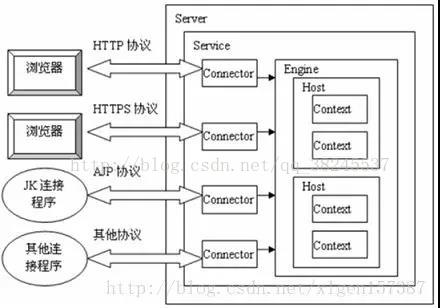SpringBoot内置tomcat启动原理
前言
不得不说SpringBoot的开发者是在为大众程序猿谋福利,把大家都惯成了懒汉,xml不配置了,连tomcat也懒的配置了,典型的一键启动系统,那么tomcat在springboot是怎么启动的呢?
内置tomcat
开发阶段对我们来说使用内置的tomcat是非常够用了,当然也可以使用jetty。
<dependency>
<groupId>org.springframework.boot</groupId>
<artifactId>spring-boot-starter-web</artifactId>
<version>2.1.6.RELEASE</version>
</dependency>
@SpringBootApplication
public class MySpringbootTomcatStarter{
public static void main(String[] args) {
Long time=System.currentTimeMillis();
SpringApplication.run(MySpringbootTomcatStarter.class);
System.out.println("===应用启动耗时:"+(System.currentTimeMillis()-time)+"===");
}
}
这里是main函数入口,两句代码最耀眼,分别是SpringBootApplication注解和SpringApplication.run()方法。
发布生产
发布的时候,目前大多数的做法还是排除内置的tomcat,打瓦包(war)然后部署在生产的tomcat中,好吧,那打包的时候应该怎么处理?
<dependency>
<groupId>org.springframework.boot</groupId>
<artifactId>spring-boot-starter-web</artifactId>
<!-- 移除嵌入式tomcat插件 -->
<exclusions>
<exclusion>
<groupId>org.springframework.boot</groupId>
<artifactId>spring-boot-starter-tomcat</artifactId>
</exclusion>
</exclusions>
</dependency>
<!--添加servlet-api依赖--->
<dependency>
<groupId>javax.servlet</groupId>
<artifactId>javax.servlet-api</artifactId>
<version>3.1.0</version>
<scope>provided</scope>
</dependency>
更新main函数,主要是继承SpringBootServletInitializer,并重写configure()方法。
@SpringBootApplication
public class MySpringbootTomcatStarter extends SpringBootServletInitializer {
public static void main(String[] args) {
Long time=System.currentTimeMillis();
SpringApplication.run(MySpringbootTomcatStarter.class);
System.out.println("===应用启动耗时:"+(System.currentTimeMillis()-time)+"===");
}
@Override
protected SpringApplicationBuilder configure(SpringApplicationBuilder builder) {
return builder.sources(this.getClass());
}
}
从main函数说起
public static ConfigurableApplicationContext run(Class<?> primarySource, String... args) {
return run(new Class[]{primarySource}, args);
}
--这里run方法返回的是ConfigurableApplicationContext
public static ConfigurableApplicationContext run(Class<?>[] primarySources, String[] args) {
return (new SpringApplication(primarySources)).run(args);
}
public ConfigurableApplicationContext run(String... args) {
ConfigurableApplicationContext context = null;
Collection<SpringBootExceptionReporter> exceptionReporters = new ArrayList();
this.configureHeadlessProperty();
SpringApplicationRunListeners listeners = this.getRunListeners(args);
listeners.starting();
Collection exceptionReporters;
try {
ApplicationArguments applicationArguments = new DefaultApplicationArguments(args);
ConfigurableEnvironment environment = this.prepareEnvironment(listeners, applicationArguments);
this.configureIgnoreBeanInfo(environment);
//打印banner,这里你可以自己涂鸦一下,换成自己项目的logo
Banner printedBanner = this.printBanner(environment);
//创建应用上下文
context = this.createApplicationContext();
exceptionReporters = this.getSpringFactoriesInstances(SpringBootExceptionReporter.class, new Class[]{ConfigurableApplicationContext.class}, context);
//预处理上下文
this.prepareContext(context, environment, listeners, applicationArguments, printedBanner);
//刷新上下文
this.refreshContext(context);
//再刷新上下文
this.afterRefresh(context, applicationArguments);
listeners.started(context);
this.callRunners(context, applicationArguments);
} catch (Throwable var10) {
}
try {
listeners.running(context);
return context;
} catch (Throwable var9) {
}
}
既然我们想知道tomcat在SpringBoot中是怎么启动的,那么run方法中,重点关注创建应用上下文(createApplicationContext)和刷新上下文(refreshContext)。
创建上下文
//创建上下文
protected ConfigurableApplicationContext createApplicationContext() {
Class<?> contextClass = this.applicationContextClass;
if (contextClass == null) {
try {
switch(this.webApplicationType) {
case SERVLET:
//创建AnnotationConfigServletWebServerApplicationContext
contextClass = Class.forName("org.springframework.boot.web.servlet.context.AnnotationConfigServletWebServerApplicationContext");
break;
case REACTIVE:
contextClass = Class.forName("org.springframework.boot.web.reactive.context.AnnotationConfigReactiveWebServerApplicationContext");
break;
default:
contextClass = Class.forName("org.springframework.context.annotation.AnnotationConfigApplicationContext");
}
} catch (ClassNotFoundException var3) {
throw new IllegalStateException("Unable create a default ApplicationContext, please specify an ApplicationContextClass", var3);
}
}
return (ConfigurableApplicationContext)BeanUtils.instantiateClass(contextClass);
}
这里会创建AnnotationConfigServletWebServerApplicationContext类。
而AnnotationConfigServletWebServerApplicationContext类继承了ServletWebServerApplicationContext,而这个类是最终集成了AbstractApplicationContext。
刷新上下文
//SpringApplication.java
//刷新上下文
private void refreshContext(ConfigurableApplicationContext context) {
this.refresh(context);
if (this.registerShutdownHook) {
try {
context.registerShutdownHook();
} catch (AccessControlException var3) {
}
}
}
//这里直接调用最终父类AbstractApplicationContext.refresh()方法
protected void refresh(ApplicationContext applicationContext) {
((AbstractApplicationContext)applicationContext).refresh();
}
//AbstractApplicationContext.java
public void refresh() throws BeansException, IllegalStateException {
synchronized(this.startupShutdownMonitor) {
this.prepareRefresh();
ConfigurableListableBeanFactory beanFactory = this.obtainFreshBeanFactory();
this.prepareBeanFactory(beanFactory);
try {
this.postProcessBeanFactory(beanFactory);
this.invokeBeanFactoryPostProcessors(beanFactory);
this.registerBeanPostProcessors(beanFactory);
this.initMessageSource();
this.initApplicationEventMulticaster();
//调用各个子类的onRefresh()方法,也就说这里要回到子类:ServletWebServerApplicationContext,调用该类的onRefresh()方法
this.onRefresh();
this.registerListeners();
this.finishBeanFactoryInitialization(beanFactory);
this.finishRefresh();
} catch (BeansException var9) {
this.destroyBeans();
this.cancelRefresh(var9);
throw var9;
} finally {
this.resetCommonCaches();
}
}
}
//ServletWebServerApplicationContext.java
//在这个方法里看到了熟悉的面孔,this.createWebServer,神秘的面纱就要揭开了。
protected void onRefresh() {
super.onRefresh();
try {
this.createWebServer();
} catch (Throwable var2) {
}
}
//ServletWebServerApplicationContext.java
//这里是创建webServer,但是还没有启动tomcat,这里是通过ServletWebServerFactory创建,那么接着看下ServletWebServerFactory
private void createWebServer() {
WebServer webServer = this.webServer;
ServletContext servletContext = this.getServletContext();
if (webServer == null && servletContext == null) {
ServletWebServerFactory factory = this.getWebServerFactory();
this.webServer = factory.getWebServer(new ServletContextInitializer[]{this.getSelfInitializer()});
} else if (servletContext != null) {
try {
this.getSelfInitializer().onStartup(servletContext);
} catch (ServletException var4) {
}
}
this.initPropertySources();
}
//接口
public interface ServletWebServerFactory {
WebServer getWebServer(ServletContextInitializer... initializers);
}
//实现
AbstractServletWebServerFactory
JettyServletWebServerFactory
TomcatServletWebServerFactory
UndertowServletWebServerFactory
这里ServletWebServerFactory接口有4个实现类

而其中我们常用的有两个:TomcatServletWebServerFactory和JettyServletWebServerFactory。
//TomcatServletWebServerFactory.java
//这里我们使用的tomcat,所以我们查看TomcatServletWebServerFactory。到这里总算是看到了tomcat的踪迹。
@Override
public WebServer getWebServer(ServletContextInitializer... initializers) {
Tomcat tomcat = new Tomcat();
File baseDir = (this.baseDirectory != null) ? this.baseDirectory : createTempDir("tomcat");
tomcat.setBaseDir(baseDir.getAbsolutePath());
//创建Connector对象
Connector connector = new Connector(this.protocol);
tomcat.getService().addConnector(connector);
customizeConnector(connector);
tomcat.setConnector(connector);
tomcat.getHost().setAutoDeploy(false);
configureEngine(tomcat.getEngine());
for (Connector additionalConnector : this.additionalTomcatConnectors) {
tomcat.getService().addConnector(additionalConnector);
}
prepareContext(tomcat.getHost(), initializers);
return getTomcatWebServer(tomcat);
}
protected TomcatWebServer getTomcatWebServer(Tomcat tomcat) {
return new TomcatWebServer(tomcat, getPort() >= 0);
}
//Tomcat.java
//返回Engine容器,看到这里,如果熟悉tomcat源码的话,对engine不会感到陌生。
public Engine getEngine() {
Service service = getServer().findServices()[0];
if (service.getContainer() != null) {
return service.getContainer();
}
Engine engine = new StandardEngine();
engine.setName( "Tomcat" );
engine.setDefaultHost(hostname);
engine.setRealm(createDefaultRealm());
service.setContainer(engine);
return engine;
}
//Engine是最高级别容器,Host是Engine的子容器,Context是Host的子容器,Wrapper是Context的子容器
getWebServer这个方法创建了Tomcat对象,并且做了两件重要的事情:把Connector对象添加到tomcat中,configureEngine(tomcat.getEngine());
getWebServer方法返回的是TomcatWebServer。
//TomcatWebServer.java
//这里调用构造函数实例化TomcatWebServer
public TomcatWebServer(Tomcat tomcat, boolean autoStart) {
Assert.notNull(tomcat, "Tomcat Server must not be null");
this.tomcat = tomcat;
this.autoStart = autoStart;
initialize();
}
private void initialize() throws WebServerException {
//在控制台会看到这句日志
logger.info("Tomcat initialized with port(s): " + getPortsDescription(false));
synchronized (this.monitor) {
try {
addInstanceIdToEngineName();
Context context = findContext();
context.addLifecycleListener((event) -> {
if (context.equals(event.getSource()) && Lifecycle.START_EVENT.equals(event.getType())) {
removeServiceConnectors();
}
});
//===启动tomcat服务===
this.tomcat.start();
rethrowDeferredStartupExceptions();
try {
ContextBindings.bindClassLoader(context, context.getNamingToken(), getClass().getClassLoader());
}
catch (NamingException ex) {
}
//开启阻塞非守护进程
startDaemonAwaitThread();
}
catch (Exception ex) {
stopSilently();
destroySilently();
throw new WebServerException("Unable to start embedded Tomcat", ex);
}
}
}
//Tomcat.java
public void start() throws LifecycleException {
getServer();
server.start();
}
//这里server.start又会回到TomcatWebServer的
public void stop() throws LifecycleException {
getServer();
server.stop();
}
//TomcatWebServer.java
//启动tomcat服务
@Override
public void start() throws WebServerException {
synchronized (this.monitor) {
if (this.started) {
return;
}
try {
addPreviouslyRemovedConnectors();
Connector connector = this.tomcat.getConnector();
if (connector != null && this.autoStart) {
performDeferredLoadOnStartup();
}
checkThatConnectorsHaveStarted();
this.started = true;
//在控制台打印这句日志,如果在yml设置了上下文,这里会打印
logger.info("Tomcat started on port(s): " + getPortsDescription(true) + " with context path '"
+ getContextPath() + "'");
}
catch (ConnectorStartFailedException ex) {
stopSilently();
throw ex;
}
catch (Exception ex) {
throw new WebServerException("Unable to start embedded Tomcat server", ex);
}
finally {
Context context = findContext();
ContextBindings.unbindClassLoader(context, context.getNamingToken(), getClass().getClassLoader());
}
}
}
//关闭tomcat服务
@Override
public void stop() throws WebServerException {
synchronized (this.monitor) {
boolean wasStarted = this.started;
try {
this.started = false;
try {
stopTomcat();
this.tomcat.destroy();
}
catch (LifecycleException ex) {
}
}
catch (Exception ex) {
throw new WebServerException("Unable to stop embedded Tomcat", ex);
}
finally {
if (wasStarted) {
containerCounter.decrementAndGet();
}
}
}
}
附:tomcat顶层结构图

tomcat最顶层容器是Server,代表着整个服务器,一个Server包含多个Service。从上图可以看除Service主要包括多个Connector和一个Container。Connector用来处理连接相关的事情,并提供Socket到Request和Response相关转化。Container用于封装和管理Servlet,以及处理具体的Request请求。那么上文提到的Engine>Host>Context>Wrapper容器又是怎么回事呢? 我们来看下图:

综上所述,一个tomcat只包含一个Server,一个Server可以包含多个Service,一个Service只有一个Container,但有多个Connector,这样一个服务可以处理多个连接。
多个Connector和一个Container就形成了一个Service,有了Service就可以对外提供服务了,但是Service要提供服务又必须提供一个宿主环境,那就非Server莫属了,所以整个tomcat的声明周期都由Server控制。
总结
SpringBoot的启动主要是通过实例化SpringApplication来启动的,启动过程主要做了以下几件事情:配置属性、获取监听器,发布应用开始启动事件初、始化输入参数、配置环境,输出banner、创建上下文、预处理上下文、刷新上下文、再刷新上下文、发布应用已经启动事件、发布应用启动完成事件。在SpringBoot中启动tomcat的工作在刷新上下这一步。而tomcat的启动主要是实例化两个组件:Connector、Container,一个tomcat实例就是一个Server,一个Server包含多个Service,也就是多个应用程序,每个Service包含多个Connector和一个Container,而一个Container下又包含多个子容器。
SpringBoot内置tomcat启动原理的更多相关文章
- springboot学习笔记:6.内置tomcat启动和外部tomcat部署总结
springboot的web项目的启动主要分为: 一.使用内置tomcat启动 启动方式: 1.IDEA中main函数启动 2.mvn springboot-run 命令 3.java -jar XX ...
- Spring Boot 添加jersey-mvc-freemarker依赖后内置tomcat启动不了解决方案
我在我的Spring Boot 项目的pom.xml中添加了jersey-mvc-freemarker依赖后,内置tomcat启动不了. 报错信息如下: org.springframework.con ...
- Spring Boot:内置tomcat启动和外部tomcat部署总结
springboot的web项目的启动主要分为: 一.使用内置tomcat启动 启动方式: 1.IDEA中main函数启动 2.mvn springboot-run 命令 3.java -jar XX ...
- springboot内置tomcat验证授权回调页面域名
springboot内置tomcat验证公众号授权回调页面域名 解决方法: 网上下载一个tomcat,在server.xml文件中修改端口为springboot内置tomcat的端口号,复制验证文件到 ...
- 去除springboot内置tomcat
/** * @author zx * @title: ServletInitializer * @projectName activiti * @description: 解决内置tomcat * @ ...
- springboot不使用内置tomcat启动,用jetty或undertow
Spring Boot启动程序通常使用Tomcat作为默认的嵌入式服务器.如果需要更改 - 您可以排除Tomcat依赖项并改为包含Jetty或Undertow: jetty配置: <depend ...
- 1.springboot内置tomcat的connection相关
最近在研究tomcat的连接超时问题,环境:jdk1.8 + springboot 2.1.1.RELEASE,以下仅为个人理解,如果异议,欢迎指正. springboot的tomcat的几个配置参数 ...
- Springboot 内置tomcat 基本配置收集整理
配置一: server:# tomcat 配置 tomcat: # 接收队列长度 accept-count: 1000 # 最小空闲线程数 min-spare-threads ...
- eclipse内置tomcat启动方法
tomcat:run -Dmaven.tomcat.port=
随机推荐
- 1.Actor编写-ESGrain与ESRepGrain
ESGrain 生命周期 Ray中ESGrain继承自Grain扩展了Grain的生命周期.Grain的生命周期参见文档附录:1-Grain生命周期-译注.md ESGrain重写了Grain的OnA ...
- JavaScript入门小案例
笔记: <!-- JavaScript的特点: 1.基于对象和事件驱动 JavaScript把HTML页面中的每一个元素都当做一个对象来处理,并且这些对象都具有层次关系, 像一颗倒立的树,这种关 ...
- 【动态规划法(DP)】-C++
360百科定义: 动态规划(dynamic programming)是运筹学的一个分支,是求解决策过程(decision process)最优化的数学方法.20世纪50年代初美国数学家R.E.Bell ...
- xx.exe 中的 0x014180bd 处有未经处理的异常: 0xC0000005: 读取位置 0xfeeefeee 时发生访问冲突(当指针访问异常时,应考虑是不是对象未创建)。
xx.exe 中的 0x014180bd 处有未经处理的异常: 0xC0000005: 读取位置 0xfeeefeee 时发生访问冲突
- 使用java语言基于SMTP协议手写邮件客户端
使用java语言基于SMTP协议手写邮件客户端 1. 说明 电子邮件是互联网上常见的应用,他是互联网早期的产品,直至今日依然受到广大用户的喜爱(在中国可能因为文化背景不同,电子邮件只在办公的时候常用) ...
- Hive的架构原理&Hive的安装步骤
Hive架构图 元数据默认数据库是:Derby.开发使用MySQL Hive如何将SQL语句翻译成MapReduce的? 1.使用SQL解析器解析SQL语句 2.使用编译器进行编译逻辑 3.使用优化器 ...
- java优化之 单例模式的优化
该分类下的文章均为笔者阅读<Java程序性能优化>(葛一鸣)一书之所理解.如有欠缺,还请大佬们指点.
- [PTA] 1001. 害死人不偿命的(3n+1)猜想 (Basic)
import java.util.*; public class Main { public static void main(String[] args) { Scanner sc = new Sc ...
- 抽象数据类型与C++
类是一种新的数据类型,类似于数据结构,只是它拥有数据结构所没有的部分——“成员函数”,正是因为它所拥有的成员函数这一特性,使得它能隐藏“数据结构”(类)中的数据,不被用户所知道.通过类中的成员函数,使 ...
- 2019牛客多校第一场 E-ABBA(dp)
ABBA 题目传送门 解题思路 用dp[i][j]来表示前i+j个字符中,有i个A和j个B的合法情况个数.我们可以让前n个A作为AB的A,因为如果我们用后面的A作为AB的A,我们一定也可以让前面的A对 ...
